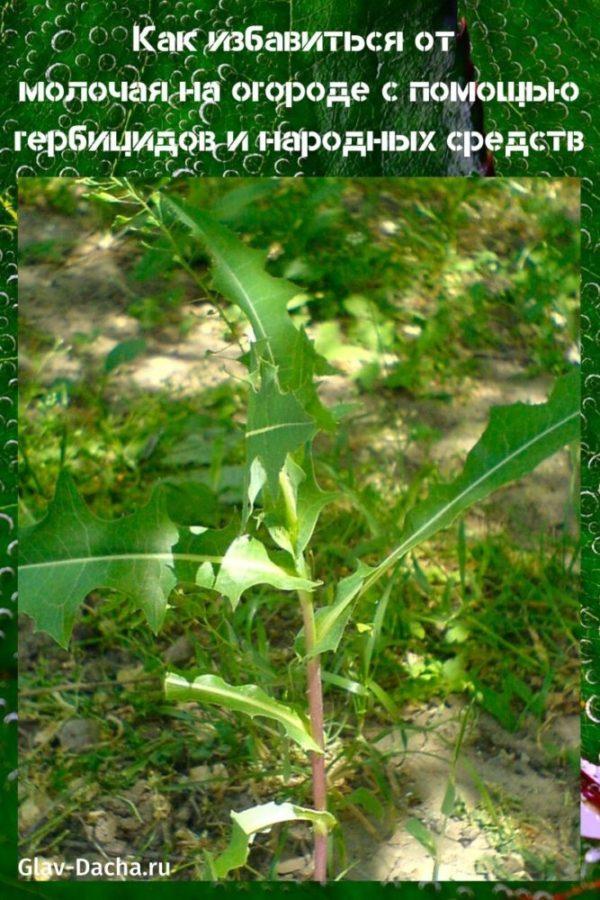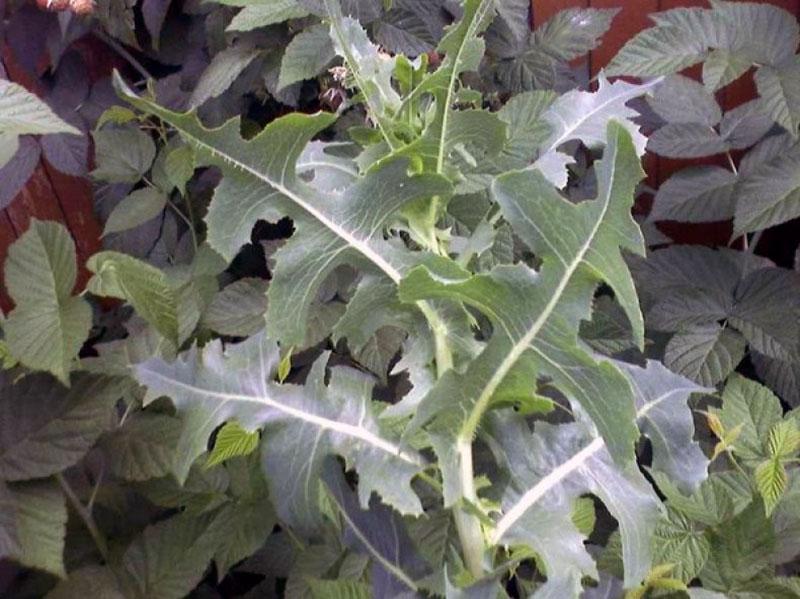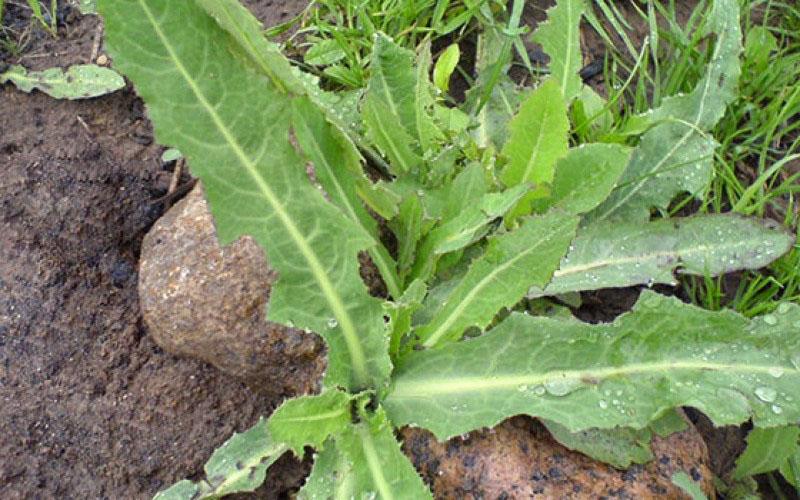How to get rid of milkweed in the garden using herbicides and folk remedies
 Euphorbia is one of the most common weeds, causing serious harm to garden crops and hindering their full growth. There are several ways how to get rid of milkweed in the garden - agrotechnical methods, the use of chemical herbicides and safe folk remedies.
Euphorbia is one of the most common weeds, causing serious harm to garden crops and hindering their full growth. There are several ways how to get rid of milkweed in the garden - agrotechnical methods, the use of chemical herbicides and safe folk remedies.
Types and description of milkweed

Euphorbia has several characteristic features:
- plant height - up to 30-80 cm, some species can reach 4-5 m;
- the root system is branched, massive, creeping, can spread up to 1-1.5 m in depth;
- the stem is wide and thick, with axillary peduncles at the top;
- inside the stem contains a poisonous white juice that looks like milk - that is why the plant got its name;
- the leaves are triangular, the edges are covered with sharp thorns;
- milkweed seeds remain viable for up to 5-7 years.
More than 120 species of milkweed grow on the territory of Russia. The most common euphorbia homophyllus, wild, vine, sharp, Zhigulevsky, twig-like and official euphorbia in the garden.
 The main danger of milkweed in the garden is its rapid spread. The branchy root system of the weed spreads over the site by 45-50 cm, taking moisture from the soil. This leads to the suppression of the growth of garden crops, their low productivity.
The main danger of milkweed in the garden is its rapid spread. The branchy root system of the weed spreads over the site by 45-50 cm, taking moisture from the soil. This leads to the suppression of the growth of garden crops, their low productivity.
Euphorbia interferes with the full life and growth of cultivated plants grown in the garden. Its rhizome sucks out all the nutrients from the soil, impoverishing it, leading to diseases and death of vegetable plants.
Agrotechnical control methods
 The fight against milkweed in the garden is long and laborious, since this plant is able to quickly adapt to adverse environmental conditions. For removing weeds various methods of control are used - agrotechnical, the use of herbicides and folk remedies.
The fight against milkweed in the garden is long and laborious, since this plant is able to quickly adapt to adverse environmental conditions. For removing weeds various methods of control are used - agrotechnical, the use of herbicides and folk remedies.
 Agrotechnical methods of control consist in mechanical removal of the weed from the root. This is best done in early spring, until its root system has grown and active life has begun. The plant needs to be dug up with a shovel. But this method is not suitable for removing old weeds, as their roots can go up to 1 m into the soil.
Agrotechnical methods of control consist in mechanical removal of the weed from the root. This is best done in early spring, until its root system has grown and active life has begun. The plant needs to be dug up with a shovel. But this method is not suitable for removing old weeds, as their roots can go up to 1 m into the soil.
Before you get rid of milkweed in your garden plot, you need to remember that the more you mow or cut off its aboveground part, the faster its root system grows and spreads. Therefore, it is very important not to leave even the smallest roots.
In October-November, after harvesting, the soil must be dug deeply, and then mulched. This will damage the remaining milkweed roots and prevent the next year from growing.
Digging up milkweed should only be carried out with rubber gloves, as its juice can cause skin burns.
How to get rid of milkweed with herbicides
One way to quickly get rid of milkweed in your garden is to use chemical herbicides.
The most popular and effective drugs include:
- Lapis lazuli;
- Dicamba;
- Roundup;
- Napalm;
- Titus.
 Lapis lazuli is applied after preliminary digging of the soil. The solution is prepared at the rate of 10 g per 3 liters of water, after which the weeds are sprayed. A plot of 1 hectare will require a herbicide solution in a concentration of up to 1.3-1.5 kg. The first treatment should be carried out before the appearance of milkweed sprouts, the second - when the seedlings of vegetable crops reach 5-6 cm.
Lapis lazuli is applied after preliminary digging of the soil. The solution is prepared at the rate of 10 g per 3 liters of water, after which the weeds are sprayed. A plot of 1 hectare will require a herbicide solution in a concentration of up to 1.3-1.5 kg. The first treatment should be carried out before the appearance of milkweed sprouts, the second - when the seedlings of vegetable crops reach 5-6 cm.
 Dicamba - for spraying 1 hectare of a vegetable garden, 1.5-2 liters of solution will be required. The remedy is best used after 3-4 leaves have formed on the milkweed. Treatment with this herbicide should be carried out at least 4-5 weeks before harvest. The advantage of this herbicide is fast and long-lasting action, the disadvantage is the high level of toxicity.
Dicamba - for spraying 1 hectare of a vegetable garden, 1.5-2 liters of solution will be required. The remedy is best used after 3-4 leaves have formed on the milkweed. Treatment with this herbicide should be carried out at least 4-5 weeks before harvest. The advantage of this herbicide is fast and long-lasting action, the disadvantage is the high level of toxicity.
Roundup - an effective remedy for the destruction of milkweed, which is prepared from a bucket of water and 100 ml of herbicide. It is used to process fruit, vegetable and grain crops. Weed management is best done in dry and calm weather, in the early morning or evening.
 Napalm is a broad spectrum herbicide designed to control milkweed and other weeds. To prepare a working solution, you need to dilute 90-120 ml of the drug in 10 liters of water, and then pour it over the soil where the spurge grows.
Napalm is a broad spectrum herbicide designed to control milkweed and other weeds. To prepare a working solution, you need to dilute 90-120 ml of the drug in 10 liters of water, and then pour it over the soil where the spurge grows.
 Titus - to prepare a working solution, dilute 40-50 ml of the drug in a bucket of clean water. Spraying of soil with weeds should be carried out in calm weather, at an air temperature not higher than + 25 ° С.
Titus - to prepare a working solution, dilute 40-50 ml of the drug in a bucket of clean water. Spraying of soil with weeds should be carried out in calm weather, at an air temperature not higher than + 25 ° С.
When processing a vegetable garden, you need to carefully monitor so that the herbicidal agent does not get on vegetable crops. Plants can be covered with plastic wrap for added protection.
Weed control folk remedies
 Many gardeners prefer to fight milkweed in their garden with the help of folk remedies. They are highly effective and do not harm either fertile soil or vegetable crops.
Many gardeners prefer to fight milkweed in their garden with the help of folk remedies. They are highly effective and do not harm either fertile soil or vegetable crops.
How to remove spurge weed in the garden with folk remedies:
- Sprinkle the soil with table salt and sprinkle with water - this method prevents the growth of milkweed.
- Spray the leaves and stems of the weed with table vinegar, keeping the acid away from the vegetable plants.
- Water the area with a concentrated soda solution.
A vinegar solution with soap shavings is considered an effective folk remedy. To prepare it, pour 2-3 tablespoons of acetic acid and grated laundry soap into a bucket of clean water. This solution is used to irrigate the soil with weeds.
Folk remedies can be combined with herbicides - this will help to quickly destroy euphorbia in the garden. Independent use of folk recipes is most effective with a small amount of weeds on the site.
Prevention of milkweed
 After the destruction of milkweed, it is very important to consolidate the result. For this, a deep digging of the soil is carried out on the site, as well as its mulching with organic and inorganic substances. The former include crushed tree bark, sawdust, wood chips, shavings, pieces of cardboard or paper, rotted manure or foliage.
After the destruction of milkweed, it is very important to consolidate the result. For this, a deep digging of the soil is carried out on the site, as well as its mulching with organic and inorganic substances. The former include crushed tree bark, sawdust, wood chips, shavings, pieces of cardboard or paper, rotted manure or foliage.
 Inorganic substances for mulching can be bought in a specialized store - these are various spunbonds, special breathable films. They are excellent at stopping the growth of weeds.
Inorganic substances for mulching can be bought in a specialized store - these are various spunbonds, special breathable films. They are excellent at stopping the growth of weeds.
Also, to prevent the appearance of milkweed, you can use folk remedies - water the area where it is planned to plant vegetable crops with a solution of water and alcohol, taken in a ratio of 1:10.
Euphorbia is one of the most common and difficult to remove weeds that bother many gardeners and can lead to the death of vegetable crops. For weed control, safe folk remedies and chemicals are used, the effectiveness of which can be increased by agrotechnical methods of control.